Learn how to make Pineapple Upside-Down Cake, a sweet retro American treat. A history and vintage-inspired recipe from food historian Gil Marks.
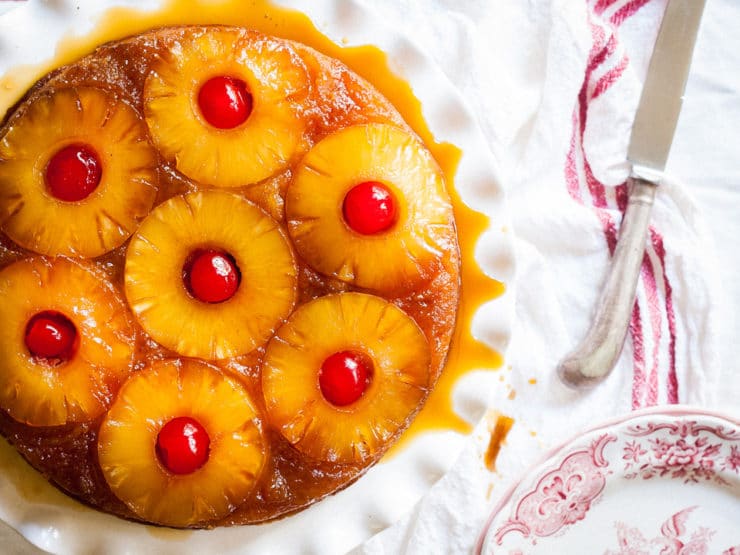
What is Pineapple Upside-Down Cake?
Pineapple upside-down cake is a single layer basic yellow butter cake inverted after baking to reveal a glistening mosaic of caramelized canned pineapple. Any frosting or additional gilding is unwarranted. A variation of this treat was upside-down pudding, consisting of a Victoria sponge cake inverted after baking to reveal a decorative fruit layer.
Where Did the Pineapple Upside-Down Cake Originate?
Cooking a cake or tart with a fruit layer on the bottom and afterwards inverting it is neither new nor indigenous to America. Among the most famous of these treats is the French tarte tatin, an early 20th century upside-down apple tart. Around that time, Mrs. Allen’s Cook Book by Ida Allen (Boston, 1917) contained four upside-down pies, such as “Upside-Down Apple Pie.” Central Europeans have long enjoyed schmarren by cooking apple slices in a skillet, adding a pancake batter, then inverting it to reveal the apples on top. In a similar manner, the English prepared various skillet custards and puddings called a tansy, the name derived from a European bitter herb that was initially added as a flavoring. Tansy in colonial America, absent the herb, was made by cooking sliced tart apple rounds in a skillet, adding beaten eggs flavored with sugar, rosewater, and nutmeg, cooking it until set, then inverting it onto a plate.
In the 19th century, Americans without access to an oven made cornbreads, biscuits, and shortcakes over the coals of a fire in a spider (a cast-iron skillet with legs – more common than a plain skillet through much of the 19th century), which by the mid-1800s became known as spider cakes. These were frequently served warm for breakfast. As the home iron oven became increasingly commonplace in the country, flat-bottomed frying pans supplanted the spider and the term skillet cake emerged. In addition, Americans began baking chemically-leavened butter cakes in the skillets. To enhance the simple cake, huckleberries might be stirred into the batter or various fruits mixed with a sugar-and-butter syrup before adding the batter to the pan. Blackened cast-iron skillets proved ideal for caramelizing the sugar, while preventing the butter from burning. The June/July 1925 issue (Vol. XXX, No 1) of “American Cookery,” formerly “The Boston Cooking-School Magazine,” noted: “A heavy iron frying pan, from eight to ten inches in diameter, is recommended, and some of our friends make the cake in an earthen baking dish.”
Skillet Cakes Become Upside-Down Cakes
In the early 1920s, a synonym emerged for skillet cakes with a caramelized fruit bottom – upside-down cake. The June/July 1925 issue of “American Cookery,” which suggested both pineapple and prunes as the fruit, explained: “This cake is variously named Pineapple Cake, Pineapple or Apricot Torte, Caramel Pudding, Frying Pan Cake, Skillet Cake, Griddle Cake, Pineapple Glace, Different Pudding, Chesterfield Pie; but Skillet or Upside-Down Cake are the commonest names.” The earliest record of the term “Upside-Down Cake” appeared in 1923 in several sources, including the March 15, 1923 issue of the Syracuse Herald (p. 15), in a column entitled “Unusual Prune Dishes,” which, as the designation connotes, provided a version made with dried plums (and no mention of pineapple). At this early point, the recipe already featured a common element of classic upside-down cakes — fruit arranged atop a brown sugar syrup in an iron skillet:
Upside-Down Cake.
Wash and soak the prunes in warm water for several hours; drain and remove pits; beat one egg till light, gradually add one-half cup of sugar; beat until creamy. Measure one cup sifted flour, sift again with one teaspoon baking powder; add to the egg mixture alternately with one quarter cup milk or water, beat well; add two tablespoons melted shortening, one teaspoon vanilla. Melt two tablespoons butter in a small iron frying pan: spread one half cup brown sugar evenly over pan, then one quarter cup chopped walnuts; cover with prunes, then pour on cake batter. Bake in a moderate oven about 25 minutes. Will serve five persons.
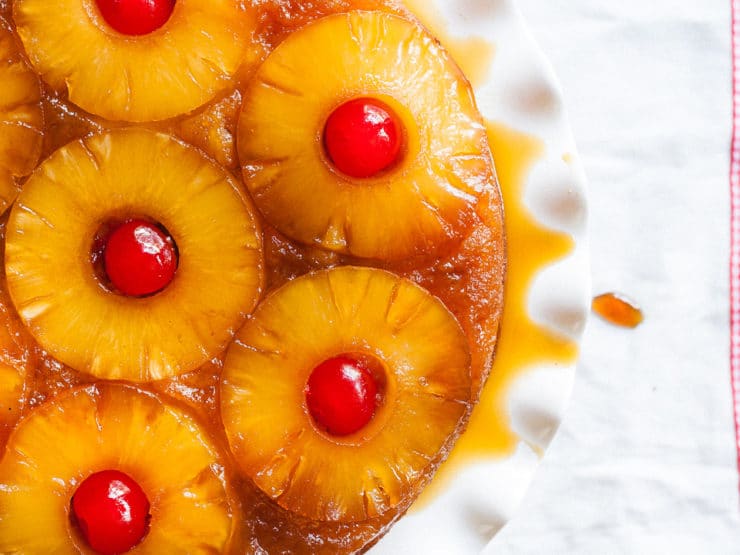
Pineapple Upside-Down Cake Becomes Popular
Besides dried plums and traditional apple slices, cooks early on experimented with various fruits in upside-down cake, generally tart ones to balance the sweet syrup. The “Upside Down Cake” in the September 11, 1926 issue of the Port Arthur News (TX) used pitted sour cherries. Canned apricot halves were another early favorite. However, the paradigmatic upside-down cake appeared when around 1923 someone substituted canned pineapple slices. No one knows the identity of the first person to use pineapple in this cake or where this occurred. Canned pineapple initially became commonplace on the American mainland after World War I and was still an exotic item in the 1920s. The earliest recipe for the pineapple variation may have been in A Book of Practical Recipes by the Chicago Evening American, which unfortunately lacks a copyright date (the newspaper was published from 1914-1939) but the accepted date among book collectors is 1923.
Pineapple Upside Down Cake
¼ pound butter
1 medium can pineapple
1 cup brown sugar
Melt butter slightly in heavy frying pan. Spread over this the brown sugar and then lay on pineapple.
(Batter)
3 eggs
1 cup flour
1 cup sugar
1 teaspoon baking powder
5 tablespoons pineapple juice
Beat egg yolks, add sugar, pineapple juice, flour sifted with baking powder. Fold in beaten egg whites. Pour over first mixture and bake in moderate oven. When done place cake plate on top of pan and reverse. Serve with whipped cream. (Pan should be eleven inches in diameter — and three inches deep.)
A Book of Practical Recipes also included a similar recipe employing the venerable term — “Caramel Pineapple Cake (Skillet Cake)”:
Caramel Pineapple Cake (Skillet Cake)
Put three tablespoonsful of butter and a cupful of brown sugar in an iron frying pan. Let it simmer for a few minutes. Then add sliced canned pineapple just to fit pan. A medium pan requires about seven slices around and one in the middle. Then make a batter of three eggs, one and a half cups of sugar, one-half cup water, one teaspoon vanilla, a pinch of salt, one and a half teaspoons baking powder, one and a half cups flour.
The pineapple concept, under various names, quickly spread nationwide. The August 1924 issue of Dietary Administration and Therapy (Cleveland, OH) provided a recipe for “Pineapple Upside Down Cake.” A cake under the title “Pineapple Glacé” was included in a 1924 community cookbook from Seattle. The cookbook of the Home Extension Clubs of Miami County (1926) contained a “Pineapple Skillet Cake.” In November 1925, a Gold Medal Flour magazine ad replete with four-color picture featured a recipe for “Pineapple Upside-Down Cake” with candied cherries, which further popularized the dish. Early on, many cooks placed pecans or walnuts in the crevices of the pineapple slices and maraschino cherries in the pineapple holes. When Dole held a pineapple recipe contest in 1926, among the 60,000 entries submitted were 2,500 for pineapple upside-down cake; at the time, still an exciting new dish. The 1931 edition of Aunt Sammy’s Radio Recipes (Uncle Sam’s wife) published by the U.S. Department of Agriculture (taken from a five-day a week 15-minute radio show) widely disseminated a printed version of the recipe (and also “Apple Upside-Down Cake”).
By the mid-1930s, this cake was one of, if not the most widely made cake in American homes. It was not only a comfort food and bake sale and potluck church social standard, but also dessert for holidays and other festive occasions. Red and green cherries rendered it a Christmas treat. As Americans increasingly purchased standardized baking utensils and lost interest in cast-iron skillets, upside-down cakes shifted primarily to round and square baking pans and the name “skillet cake” all but disappeared. The 1950s and 60s were perhaps the heyday of this cake (frequently made with boxed cake mix), as it became a pop icon. In the 1970s, as American culture and tastes changed, some began viewing upside-down cake as something of a cliché and out-of-style. Nevertheless, many home cooks continue to rely on this retro treat for a tasty dessert. April 20th became National Pineapple Upside-Down Cake Day.
Food Photography and Styling by Louise Mellor
Recommended Products:
We are a participant in the Amazon Services LLC Associates Program, an affiliate advertising program designed to provide a means for us to earn fees by linking to Amazon.com and affiliated sites. As an Amazon Associate I earn from qualifying purchases.
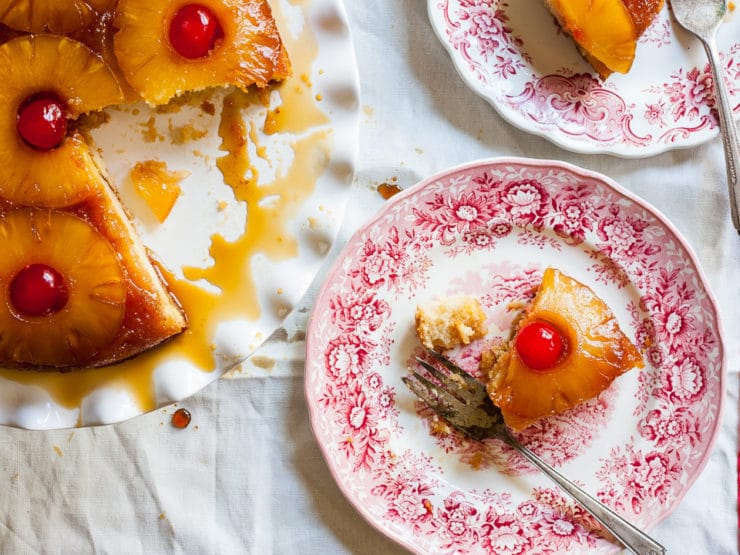
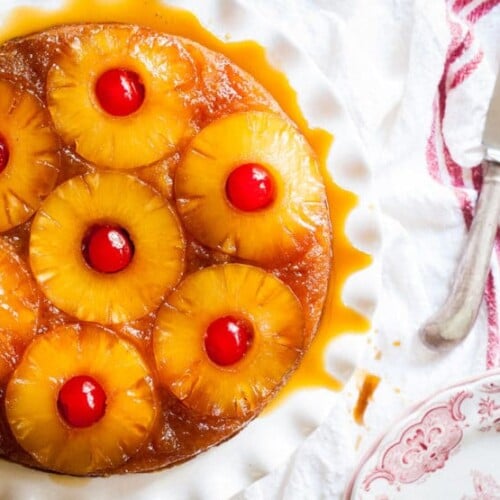
Pineapple Upside-Down Cake
Ingredients
Topping
- 1/4 cup unsalted butter, melted (½ stick/2 ounces/60 grams)
- 3/4 cup packed light brown sugar, or ½ cup light brown sugar and ¼ cup dark brown sugar (5.75 ounces/170 grams)
- 6-9 pineapple slices (½-inch thick), drained (12 to 20 ounces/340 to 570 grams), or about 2½ cups crushed pineapple, drained (20 ounces/560 grams)
- 8-12 maraschino cherries (optional)
- 1/4 cup pecan or walnut halves (optional) (1 ounce/30 grams)
Batter
- 1 3/4 cups all-purpose flour, sifted, or ¾ cup all-purpose flour and ¾ cup cake flour (7.5 ounces/210 grams)
- 1 1/2 teaspoons double-acting baking powder
- 1/2 teaspoon salt
- 1/2 teaspoon ground cinnamon, ¼ teaspoon ground mace or nutmeg, or 2 teaspoons ground cardamom or ginger (optional)
- 1/2 cup unsalted butter or 1/3 cup vegetable shortening, softened (65 to 67°F) (1 stick/4 ounces/115 grams)
- 3/4 cup granulated sugar (5.25 ounces/150 grams)
- 2 large eggs (6 tablespoons/3.5 ounces/100 grams)
- 1 1/2 teaspoons vanilla extract** (optional)
- 1/2 cup pineapple juice or milk (4.25 ounces/120 grams)
NOTES
Variations
Buttermilk Upside-Down Cake: Substitute ½ cup buttermilk or sour cream for the pineapple juice, reduce the baking powder to 1 teaspoon, and add ¼ teaspoon baking soda. Oil Upside-Down Cake: Substitute 1/3 cup vegetable oil for the butter, increase the pineapple juice or milk to ¾ cup, and add ½ teaspoon baking soda. Pina Colada Upside-Down Cake: Substitute 2/3 cup unsweetened coconut milk for the juice and add ¾ teaspoon rum extract and 1/3 cup (1 ounce/30 grams) flaked coconut. Although pineapple is the most common fruit used in upside-down cakes, many other types, fresh or canned, make tasty and interesting substitutes:- 3 to 4 (1 pound/455 grams) peeled, cored, and thinly sliced cooking apples
- 1½ cups (8.25 ounces/240 grams) drained canned apricot halves
- 3 medium (total 1 pound/455 grams) bananas cut into ¼-inch-thick slices
- 1½ to 2 cups blueberries
- 2 cups (10.5 ounces/300 grams) pitted cherries
- 2 cups (7 ounces/200 grams) cranberries
- 3 to 4 medium (1 pound/455 grams) peeled, halved, and pitted peaches or nectarines
- 8 (1 pound/455 grams) pitted and thickly sliced plums.
Instructions
To make the topping
- In a 9- to 10-inch ovenproof skillet (it will produce flared sides), 10-inch round baking pan (for straight sides), or 9-inch square baking pan, stir in the butter and sugar, then spread the mixture evenly over the pan.

- Arrange one pineapple slice in the center of the pan and the remaining slices around it. You can break some of the slices to fill in the gaps in the outer portion. If using, place the cherries and/or pecan halves (flat side up) in the centers and around the pineapple.

To make the batter
- Position a rack in the lower third of the oven. Preheat the oven to 350°F (325°F for a convection oven).Sift together the flour, baking powder, salt, and, if using, cinnamon.

- In a large bowl, beat the butter on low speed until smooth, about 2 minutes. Increase the speed to medium, gradually add the sugar, and beat until light and fluffy, about 4 minutes.

- Beat in the eggs, one at a time.

- Add the vanilla and, if using, lemon extract (or other flavoring extracts/rum). Add the flour mixture alternately with the juice (4 portions for the flour; 3 portions for the juice) beginning and ending with the flour, and beat until creamy, about 1 minute.

- Pour the batter over the pineapple.Bake until a tester inserted in the center comes out clean and the cake springs back when lightly touched or the cake reaches an internal temperature of 190°F on an instant-read thermometer, 45 to 55 minutes.

- Let the cake cool in the pan set on a wire rack for 10 minutes, then run a knife around the edge, invert onto a serving plate, and lift off the pan. Serve slightly warm or at room temperature. Wrap in plastic wrap and store at room temperature for up to 2 days or in the freezer for up to 2 months.

Nutrition

tried this recipe?
Let us know in the comments!
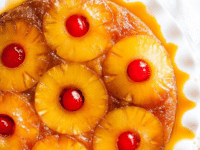
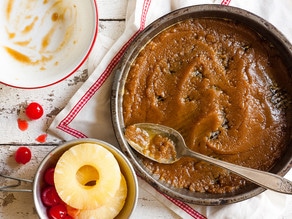
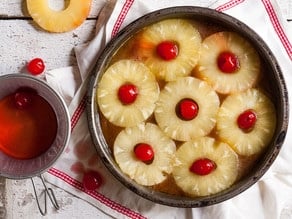
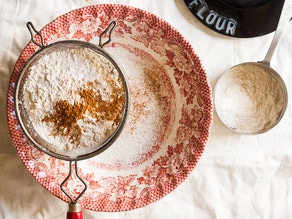
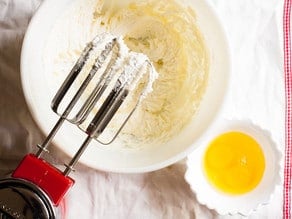
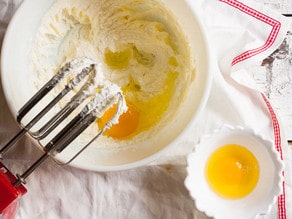
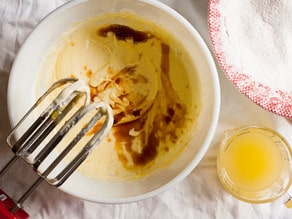
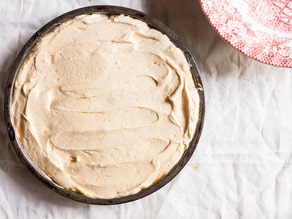
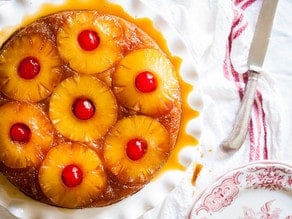


I just came across this recipe & had to share this story. My mom’s home ec class in high school had to make this cake. Everyone was partnered & they all had to do each step together at the same time. Well, the cakes were made, cooled enough to turn the cakes out, and when they did, everyone’s cake had pineapple on top except my mom’s! The sister teaching the class asked my mom if she put the pineapple in the pan or did she eat the pineapple, my mom swore she didn’t, her cooking partner swore mom didn’t (Mom’s partner was already sworn to become a nun, so the sister believed her). When they cut the cake, the slices were EXACTLY in the middle of the cake! Mom said nobody in the class (including the sister teaching) had ever heard or seen that happen to a pineapple upside-down cake, and it never happened to Mom again!
Ha! Oh dear that is strange Bridget, I’ve never heard of that happening either!
Absolutely the best cake on earth. 🙂
My mother made this in a cast iron skillet on top of thestove – best smell on earth coming home from school in the cold weather!!1
Excited about the gluten free options for this recipe, great idea for Rosh Hashana!
My absolute favorite cake, hands down…It is the only ritualized bit of cookery I do. I drain the pineapple slices, on a bed of thick paper towels, then blot them until they are bone-dry. I make the sugar and butter mix, always adding just a tiny bit more than called for in the recipe. The pineapple slices are cut in half, so they nestle into into each other and form half-moon patterns.I do NOT add the cherries, until the cake is un-molded. Then cherries are added…the crusty brown bits, the glistening fruit half-rings, the frankly artificial vivid red of the cherries…love other cakes, but not one can equal this…
Wow! I haven’t thought if this cake ages. I learned how to make it in Home Economic’s class. (Mom wasn’t much of a baker). I think I’ll make it for the niece. Thanks for the memory.
My mother used to make this and I never got her recipe. So glad I found it on The History Kitchen page!
But how do you make it with a sponge cake batter made with 13 eggs and no flour? When it rises how do you turn it over???
Not sure I understand your question Lisa… what sponge cake recipe are you referring to?
strange I just downloaded a recipe on Friday…it is really delicious and simple to make…great dessert!!
B”H
Streamline the work by mixing some butter and brown sugar in a plate, and placing it in chunks on the bottom of the baking pan randomly. It will melt during baking and form that beautiful and yummy glaze.
one of my favorites…:)
Wow, does that bring back memories. Can’t wait to try it.
Great teaseing cake, it runs even with devils food cakes in my opinion. Again that what Momma and Grandmother made, along with her Strawberry chiffon pie. Oh dear, now I’ve made my self hungry! JB
My favorite cake!
this is my most favorite cake to make..
Yummy I have made quite a few of these !!!!!
So glad that you started this blog. Learning about different cultures and history is one of the things that initially drew me towards expanding my cooking!!!
I remember baking this with my mother…
I remember being told that the cake was actually a mistake…!!! Sometimes those are the best kind… <3
Excellent cake